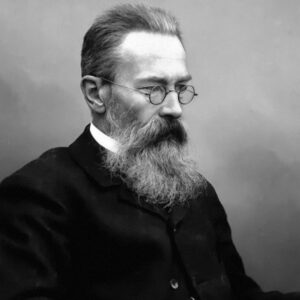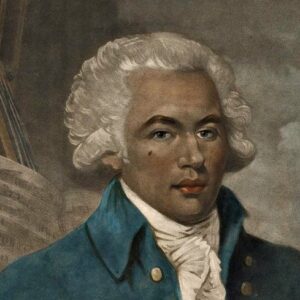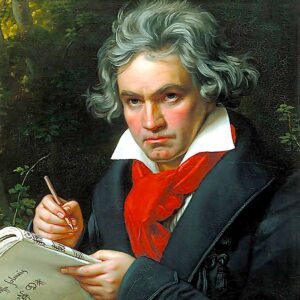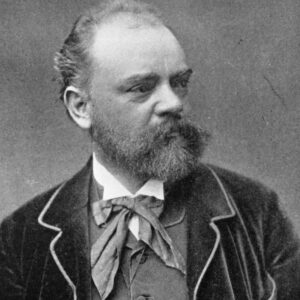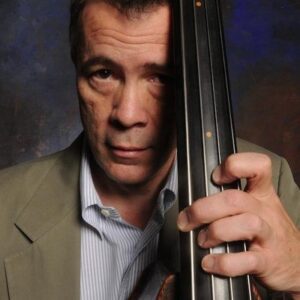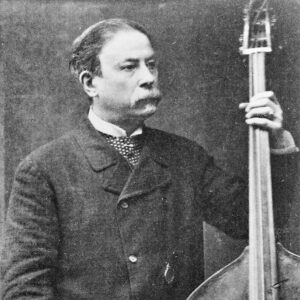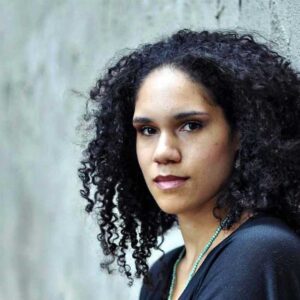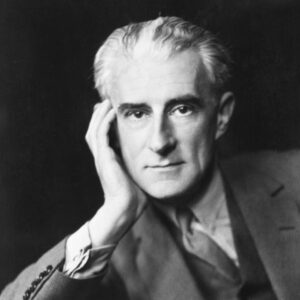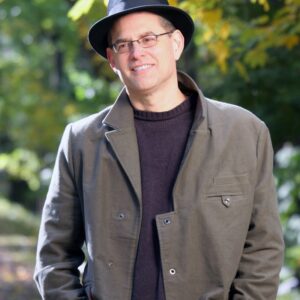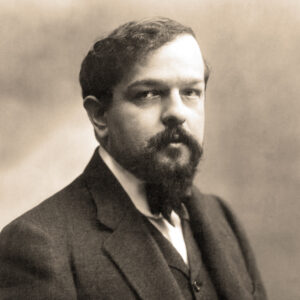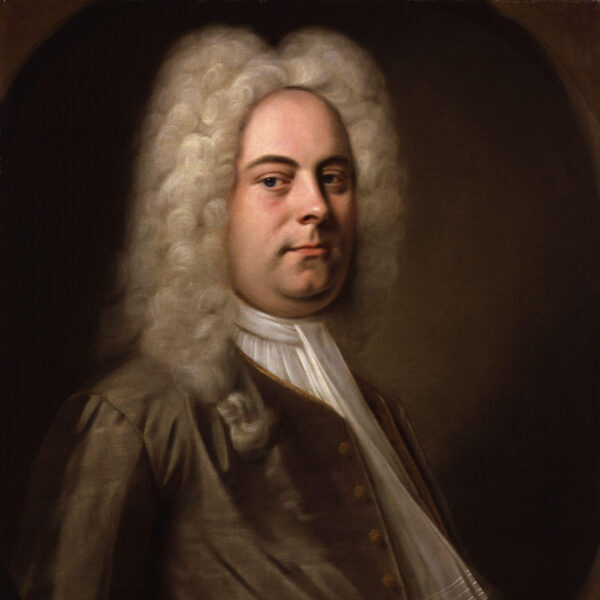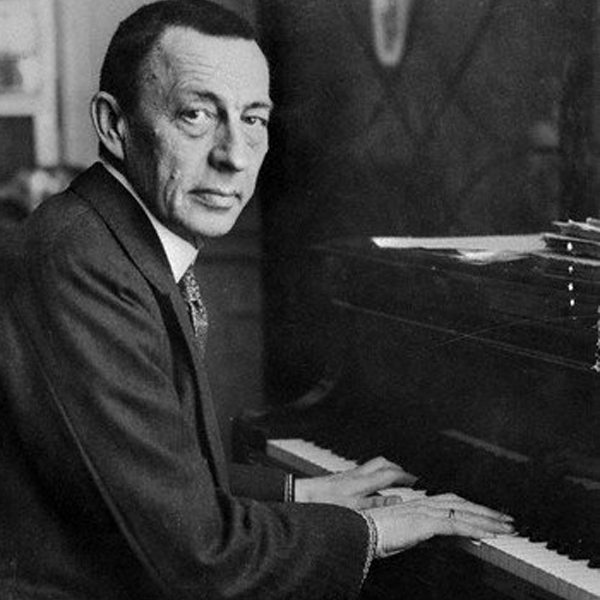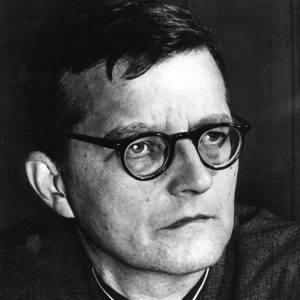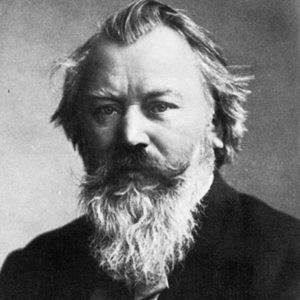Dmitri Shostakovich:
Fesitive Overture, Op. 96
Dmitri Dmitriyevich Shostakovich, one of the Soviet Union’s greatest composers, was born in Saint Petersburg on September 12, 1906 and died in Moscow on August 9, 1975. Although he composed in a wide variety of genres, he is best known for his fifteen symphonies, works that stand among the finest examples of the genre from the mid-twentieth century. His Festive Overture, a work that ostensibly was composed to celebrate the thirty-seventh anniversary of the October Revolution, was first performed by the Bolshoi Theatre Orchestra on November 6, 1954 under the baton of Alexander Melik-Pashayev. It is scored for piccolo, 2 flutes, 3 oboes, 3 clarinets, 2 bassoons, contrabassoon, 4 horns, 3 trumpets, 3 trombones, tuba, off-stage brass: 4 horns, 3 trumpets, 3 trombones, timpani, percussion, and strings.
Shostakovich is not known primarily as an “optimistic” composer. Even in his most triumphant scores, such as the finale of his popular Symphony no. 5, one senses an ironic edge surrounding its bravado fanfares and pounding kettledrums. This composer, who lived through and survived, the vicissitudes of Soviet Russia, was at his most characteristic when expressing melancholy and sarcasm.
None of these traits, however, mark his unabashedly cheerful and glitzy Festive Overture. The piece was written in great haste when Vasili Nebol’sin commissioned his colleague, Shostakovich, to provide a short work suitable to celebrate the thirty-seventh anniversary of the October (1917) Revolution. According to Lev Nikolayevich Lebedinsky (related in Elizabeth Wilson’s 1994 book, Shostakovich: A Life Remembered), the commission was a lucrative one sought after by many composers. Realizing that the date of the concert for which a commemorative piece was required was rapidly approaching, Nebol’sin beseeched Shostakovich to bail him out of his dilemma. Lebedinsky goes on to relate that Shostakovich worked at lightning-quick speed, producing a “brilliant effervescent work, with . . . vivacious energy spilling over like uncorked champagne.”
After a rousing brass fanfare, the music rushes forward, nodding strongly in the direction of Glinka’s popular overture (1842) to Russlan and Ludmilla, in a highly conventional and conservative form and harmony. The Festive Overture is crowned with a amplified return of the fanfare toward the end.
Program Note by David B. Levy, © 2014/2021
Edvard Grieg:
Piano Concerto in A minor, Op. 16
Edblovard Grieg was born in Bergen, Norway on June 15, 1843 and died there on September 4, 1907. He was a gifted composer, conductor, and pianist whose name has become virtually synonymous with Norwegian music. He is beloved throughout the world for his lyricism which derives from folk tunes and the Romantic tradition to which he belongs. Grieg’s ever popular Piano Concerto was composed in 1868 and received its first performance in Copenhagen on April 3, 1869, with Edmund Neupert as soloist. The composer revised the piece several times, publishing it in 1872. But the work did not achieve its definitive final version until shortly before the composer’s death. It is scored for 2 flutes, 2 oboes, 2 clarinets, 2 bassoons, 4 horns, 2 trumpets, 3 trombones, timpani, and strings.
Grieg was a fine pianist who wrote many fine solo and chamber works for his instrument. But he completed only one concerto. The Norwegian genius learned early in his career that the important centers for musical study were to be found elsewhere, most particularly in Denmark and Germany. His study in Leipzig, but also his contact with the Danish composer, Niels Gade, may have brought him into contact with Schumann’s Piano Concerto in the same key, and Grieg’s Piano Concerto shares many interesting points of contact with that work. But his fellow Norwegians, the violinist Ole Bull and composer Rikard Nordraak, encouraged the young Grieg to engross himself in the spirit of his native folk idioms. His Piano Concerto, which was composed within a short time of his marriage and the birth of his daughter, is an early example of this newly-found vocabulary.
The first movement’s opening gesture for the soloist, based upon descending seconds and thirds, is but one sign of how Norwegian folk music was making its impact upon his emerging style. This Allegro moderato is filled with many attractive themes, with its climax coming in a thrilling cadenza near the end. Like Schumann’s Piano Concerto, Grieg uses its slow movement as a kind of intermezzo that leads without pause into the final movement. The Allegro moderato molto e marcato is a merging of sonata and rondo form, whose principal theme is an example of a Norwegian folk dance, the Lalling. No less appealing are the tuneful middle section and the eventual transformation of the Lalling theme into a triple-meter springdans.
Notes by David B. Levy © 2011/2021
Peter Ilyich Tchaikovsky:
Symphony No. 4 in F minor, Op. 36
Peter Ilyich Tchaikovsky was born on May 7, 1840 in Votinsk, Russia and died on November 6, 1893 in Saint Petersburg. He remains one of the most popular composers of all time, beloved especially for his symphonies, ballets, and concertos. His Symphony no. 4 was composed in 1876-7 and received its first performance in Moscow on February 22,, 1878 under the baton of Nikolai Rubinstein. It is scored for piccolo, 2 flutes, 2 oboes, 2 clarinets, 2 bassoons, 4 horns, 2 trumpets, 3 trombones, tuba, timpani, percussion, and strings.
Composed in 1876-7, Tchaikovsky’s Fourth Symphony remains one of his most popular works. The composer dedicated it “to my best friend,” but this was but a thinly disguised reference to the widow, Mme. Nadezhda von Meck, a woman who had long been his staunchest supporter. In one of the more mysterious composer-patron relationships ever recorded, Tchaikovsky and von Meck never met each other.
At von Meck’s request, Tchaikovsky sent her a “program” for the Fourth Symphony, a work he called in letters to his patron “our symphony,” but this document sheds precious little light on the music. His explanation of the opening fanfare, however, is telling:
The Introduction is the kernel, the quintessence, the chief thought of the whole symphony . . . This is Fate, the fatal power which hinders one in the pursuit of happiness from gaining the goal . . .
This reference to “fate” may bring to mind Beethoven’s alleged statement that the famous four-note motif of his Symphony no. 5 represented “fate knocking at the door.” Tchaikovsky acknowledged this kinship in a letter to Sergei Taneyev. Tchaikovsky was quick to add that he had only borrowed the “central idea” of Beethoven’s symphony, not its content. Tchaikovsky’s “fate” motive, is heard at the beginning of the first movement, and returns toward the end of the finale, serving as a device to unify the four-movement symphonic cycle. This is not the only thematic recall within the piece, however, as there also is a reprise of an idea from the third movement in the finale, but it is the one that must fully grabs our attention. Tchaikovsky used similar thematic connections in his Fifth Symphony as well.
His abiding strength as a composer, however, lay not in the organic development of motivic ideas, but rather in the wealth of his melodic invention and the fire and brilliance of his orchestration. Both qualities may be found in abundance in the score to the Fourth Symphony. One also might add to the list of its assets Tchaikovsky’s ability to compose grand themes and broad rhythmic gestures derived from the world of ballet—a world to which he made, and was to continue to make, so many marvelous contributions. Who else, but the composer of Swan Lake and The Sleeping Beauty, could have written a 9/8-meter first movement “in the style of a waltz” with such seeming effortlessness? The world of Russian folk music, too, finds a voice in this symphony, as Tchaikovsky uses “The Little Birch Tree” as one of the two principal themes in the finale.
As for Tchaikovsky’s skill as an orchestrator, the Scherzo (Pizzicato ostinato) serves as a splendid example. Note the brilliance with which he handles each section of the orchestra: the plucked (pizzicato) strings, the virtuosic passagework for the winds, and the martial brass and timpani, each in turn delighting the ear.
Program Notes by David B. Levy © 2010/2021



